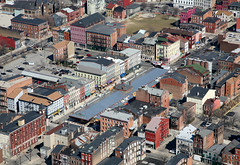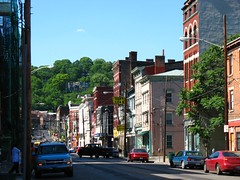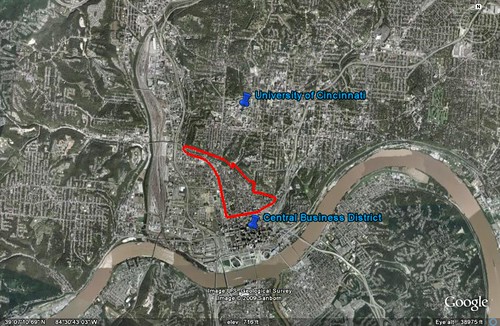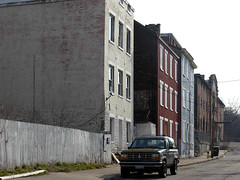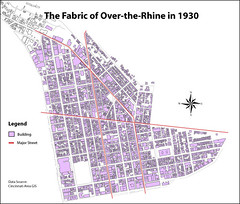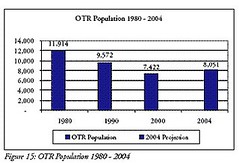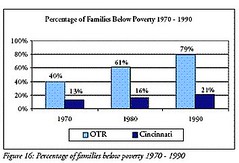Revitalizing Over-the-Rhine (Part 1: the legacy and the challenge)

Posted June 2, 2009 at 1:30PM
Cincinnati's historic and very centrally located Over-the-Rhine neighborhood is poised to become one of America's greatest revitalization stories, in the process creating a national exemplar of green, sustainable development. But a lot of things will need to happen in the right way for that ambitious vision to be realized, and there is plenty of potential for the opportunity to be missed or, worse, for it to go wrong in the doing.
I am becoming more fascinated every day by the story and the possibility of OTR, but the fabric for telling is so rich that I can't possibly say what I want to say and show you the images I want to show you in one blog post. So this will be the first of (probably) three related posts that I will run over the next couple of weeks. (I also wrote a brief introductory post on OTR in April.)
If you had asked me several months ago what I knew about Over-the-Rhine, I would have said it's a great musical duo with a strange name. That would have totally exposed my ignorance of Cincinnati and weakened my credentials as an urbanist, so thanks for not asking, though it would also have displayed my excellent musical taste, if I do say so (more about OTR the band later in this series).
But that was before I heard from Jim Uber, the energetic prof at the University of Cincinnati who co-directs UC's Sustainable Urban Environments program. Jim got in touch to invite me to participate in his program's seminar series, which I happily did last month. I have a feeling that, although I enjoyed the seminar very much, I learned more in my visit than did the UC students I spoke to, because Jim made sure that I became acquainted not just with the classroom but with colleagues in his program and others involved in OTR. They were fabulous hosts and teachers (in addition to Jim, thanks to Dan, Libby, Debbie, Colleen and John), and now I can't wait to go back, learn more, and see if there's any way NRDC and our smart growth partners can help.
As you can see from the Google Earth image, OTR is immediately north of Cincinnati's central business district, and just south of the uptown neighborhood where the University is located. As a result, the neighborhood sits right in between the region's two largest concentrations of employment. It is also right in the heart of the region's lowest per-household driving rates and carbon emissions from driving.  In the GIS map of per-household carbon emissions at left, the lightest colors have the lowest emissions. If you live in downtown Cincinnati or OTR (see blue arrow), chances are you don't have to drive very far very often, compared to others in the region, and you may not need a car at all.
In the GIS map of per-household carbon emissions at left, the lightest colors have the lowest emissions. If you live in downtown Cincinnati or OTR (see blue arrow), chances are you don't have to drive very far very often, compared to others in the region, and you may not need a car at all.
This is why I contend that the single best thing we can do with our built environment to help the planet is to revitalize our centrally located neighborhoods. OTR is an ideal candidate, with tons of character to build upon. It is Cincinnati's oldest and most historic quarter, and reportedly home to the country's largest collection (943 buildings by one count) of 19th-century Italianate architecture. The entire, 362-acre neighborhood is listed on the National Register of Historic Places. It has not been marred much if at all by inappropriate new development. That's the good news.
The not-so-good news is that the neighborhood has deteriorated badly over time. It has a long way to go to achieve long-term sustainability and, in 2006, the National Trust for Historic Preservation named OTR one of its "eleven most endangered" historic sites because of a combination of "deterioration, neglect, and poor public policy." The challenge will be to find enough capital, along with sensitive planners and builders, not just to do revitalization, but to do it in an inclusive way that respects the current residents, maintains affordability, respects the historic character of the building stock, and takes maximum advantage of green development practices.
Above are two images depicting the footprints of buildings in the neighborhood. On the left are the buildings that existed in 1930, when OTR's population was much higher than today. On the right are the footprints of buildings that existed in 1930 but no longer do. (At its peak, the neighborhood housed as many as 45,000 residents; in 2004 the population was estimated at just above 8,000.)
Of the buildings that remain, it is estimated that around 500 are vacant and deteriorating. The median annual income of the neighborhood's residents was only about $9,000 as of 2004, less than a third of the median for the city as a whole, with 79 percent of OTR's families living below the poverty line.
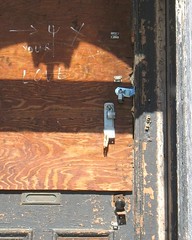 The Over-the-Rhine Foundation, which has proposed a legal mechanism for placing vacant buildings in receivership until economic conditions allow them to be rehabbed, puts it this way:
The Over-the-Rhine Foundation, which has proposed a legal mechanism for placing vacant buildings in receivership until economic conditions allow them to be rehabbed, puts it this way:
"Historic buildings throughout Over-the-Rhine and the West End sit vacant and derelict, deteriorating over years of neglect and sporadically housing vagrants, prostitutes, addicts and drug dealers. Much of our approach to this dilemma has been standardized and reactionary. When the theatre where Buffalo Bill met his wife fell into disrepair, we turned it into a parking lot. When the ornate beer hall that served as the site of an historic confrontation over temperance laws between German immigrants and City Hall started looking shabby, we turned it into a parking lot.
"Over-the-Rhine is still one of America's most historically significant neighborhoods, but it is at a tipping point. We either need to change policy and start taking historic preservation seriously or concede the loss of one of Cincinnati's most valuable potential assets and one of America's most significant historic neighborhoods."
The Foundation has a great summary of the neighborhood's colorful history. Settled by German immigrants, OTR's evocative name is said to come from workers who returned to their homes in the evenings by crossing a now-filled canal (nicknamed "the Rhine") that once separated what is now downtown Cincinnati from OTR.
Here are two more images: the bar graph on the left below shows the decline in population in OTR since 1980 (along with a hopeful, modest increase in this decade); more alarmingly, the one on the right shows the increase in the portion of OTR families in poverty between 1970 and 1990.
The Cincinnati Center City Development Corporation ("3CDC") has been initiating much of the new development activity in the district. In just a few years, it has become the neighborhood's biggest landowner. One of its goals is economic inclusion, which might provide some comfort to current residents. But maybe not: 3CDC, a nonprofit community development corporation formed in 2001 and backed with corporate money, is not always trusted in OTR, seen as "white guys in suits," according to Christopher Swope, writing in Preservation magazine. "A lot of people think we're out to displace folks and knock down buildings," one of 3CDC's leaders told Swope.
So: the potential is immense in Over-the-Rhine, but so is the challenge. Fortunately, there are some tremendous assets in the neighborhood that give one cause for optimism. That will be the subject of the next installment.

